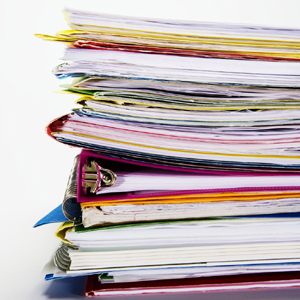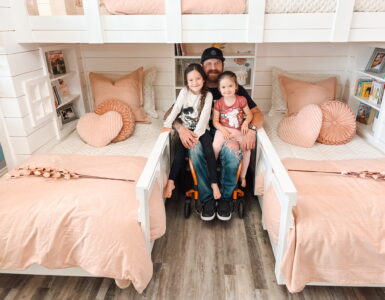Kelly Pratt is a professional organizer with Clear and Simple. She shares her ideas for taming the piles of paper.
_____________________________________________
Where are YOUR paper piles? On the kitchen counter? The dining room table? The stairs? By the side of your bed? All of the above? You are in good company! We receive so much paper and have so little training for what to do with it that things can get pretty out of hand. Here are information and tools that will help you create an active paper system so you will be in control of your incoming, most active paper.
REFERENCE VS. ACTIVE PAPER
When we talk about paper, we’re referring to all the communications that come into our lives. These communications take five forms: mail (including email), paper from other outside world sources (e.g. the newspaper, school papers, etc.), other people, the telephone, and our thoughts. All of these different areas need to be dealt with in relation to forming a paper system in order for that system to be effective.
This paper can be one of two kinds: reference or active. Reference or archival information is stuff that needs to be stored as a reference but that doesn’t need to take up prime real estate in the more active areas of our homes and offices. This includes insurance statements, mortgage statements, tax documents, and so on. The other type of paper that enters our lives is active paper. This type of paper includes papers that come home from school requiring signatures, bills to pay, invitations that require RSVPs, articles we want to read, recipes to try, etc. To stem the tide of paper insanity, we’re going to address this type of paper first. If your house were flooding due to a broken pipe, you would turn off the water and fix the pipe—not stand under the pipe and mop up the water on the floor. If your life is flooded in paper, you have to address the incoming paper first and then clean up the residue. I want to give you training and tools to help you establish a simple and effective system that will help you “fix your pipe.” To guide us through this process, we’re going to use the steps in the Clear & SIMPLE™ Systems of SEE IT. MAP IT. DO IT.© and S.T.A.C.K.S.© created by Marla Dee. Let’s begin with SEE IT.
SEE IT
Before you begin picking up your paper and making decisions about whether you’ll keep it or toss it or where you’re going to put it, it’s important to see where you are in relation to the piles. Taking a few minutes to determine the current state of your paper will help you avoid recreating your scenario over and over again. Two of my favorite ways to do this step are as to—
• Take pictures of the piles. All of them. If you have several, walk around your house detective style and ferret them out. Have fun with this exercise! Piles sometimes lurk in the most unlikely places, including in the bathroom and on the dashboard of the car. Pictures will reveal your hidden patterns; get ready to be amazed!
• Answer some questions:
o What’s working with my current paper system?
o What’s not working?
o Where am I stuck in relation to my paper? Why?
For example, maybe what’s working in your current system is that you are really good at immediately pitching junk mail. Something that’s not working may be that there’s no real home for the incoming mail, so it all gets plopped on the kitchen counter along with school papers and miscellaneous bits and scraps. Maybe you are stuck in relation to your paper because you just simply don’t know what to do with it once it comes into your space. Very few people have any paper management training, so this situation is common.
MAP IT
After you’ve taken a few minutes to SEE IT, it’s time to MAP IT. At this stage in the process, you will consider your goals when it comes to how you deal with your paper and how you want to feel about it. Here are two suggestions for creating your map:
• Create your vision for how your space will look and feel when you are not overwhelmed by your paper, when everything has a home and when you are in control of all the communications that come into your life. Write this vision down so you can refer to it as needed.
• Create a collage of pictures you find in magazines or catalogs that speak to the way you would like your space to look and feel. For example, perhaps you will find home office set-ups in a Pottery Barn catalog that have elements of your ideal space. Cut them out and mount them on a sheet of paper or poster board. This collage can be a power visual reminder of what you are trying to create
DO IT
BEFORE YOU BEGIN
There are six steps to the actual DO IT process. We’ll go through each step one at a time. Before you begin your actual paper project, however, it’s vitally important that you know exactly what you’re working with. This requires that you gather your ACTIVE piles into one location. Remember that we’re first addressing just your ACTIVE paper because it’s this type of paper that has the greatest impact on daily functioning. You may also have piles of paper that contain more reference or long-term storage type information. Place this kind of paper in its own area. If your reference and storage papers are already contained, great. If they aren’t, place your piles in banker’s boxes (available at office supply stores), and place the boxes in a storage area. We’ll focus on what to do with this paper next month.
Once you have your active paper gathered into one location, it’s time to begin!
SORT
We begin every project with a sort. To do this sorting quickly and effectively, remember the acronym RAFT: Reading, Action, File and Toss. Create four banker’s boxes, and make Post-it note labels with a Sharpie for each of these categories. All of your active paper will fit into one of these four areas. It is vitally important that you JUST SORT. Make no decisions other than in which category to put each piece of paper. JUST SORT!
The first box will contain reading material: magazines, newspaper articles, catalogs. You don’t need to decide what to do with these items just yet, just put them in the box.
The second box will contain items that require some kind of action: papers sent home from school that you need to sign, bills to pay, invitations with RSVP requests, unopened mail, grocery lists, errand lists, a special art project you want to display, etc. It’s important at this step of the process to just put the action items in the box. DO NOT TAKE THE ACTIONS YET. The primary reason I encourage you to save the actions for later is that if you get started in the doing, you will not finish your sort. There are literally 5,000 other things you will think of to do instead. We’ll talk a little later about where to put these items so they actually get done.
The third box will contain items that need to be filed: insurance statements, reconciled bank statements, warranties and instruction manuals, cards you want to keep for sentimental reasons, articles you have already read but wish to keep, etc.
The fourth box is your Toss box. You will fill this box with papers you can make a very quick decision about. If you cannot decide quickly whether or not to toss a piece of paper, place it in one of your other categories.
TOSS
After you have sorted, you will go through each item in your Reading, Action and File boxes and decide if you will keep the item or give it the boot. Let’s start with some guidelines for your Reading box.
Everything that is currently in your Reading box represents something you want to spend time reviewing, and it all takes up space. Get really honest with yourself about what you actually want to read vs. what you feel like you should read, and keep only those things that will bring you most joy and satisfaction. Let go of the rest! Aim for cutting your pile by AT LEAST half.
Next, go to your File box. Again, be realistic about what you actually want or need to keep. Because there may be many items in this box about which you might have questions, here is a link to the Clear & SIMPLE web site. Click on the Resources tab for a list of record retention guidelines. www.clearsimple.com You can also use the following guidelines from Barbara Hemphill, paper goddess of the organizing world and author of Taming the Paper Tiger at Home and Taming the Paper Tiger at Work. Be ruthless!
1. Does this require any action by me (or anyone in my household)?
2. Did I ask for this information?
3. Is this the only place the information is available?
4. Would it be difficult to replace?
5. Is the information recent enough to be useful?
6. Can I identify the specific circumstances when I would want this information?
7. Are there any tax or legal implications?
8. What’s the worst thing that could happen if I didn’t have this piece of paper? (Taming the Paper Tiger at Home, 33-34.)
Now, we arrive at the Action box. You will go through this box in the same way you did the other two boxes as you decide which actions you will actually execute and which ones you won’t. If you’re like most people, your Action stack will be fairly large. We all have lives full of want-tos, have-tos, cans and shoulds. As you go through each action paper and make clear choices about how you will spend your time, remember that you only have so much time in a day. Be realistic as you choose how you will spend your time.
As you go through this pile, divide your actions into two categories: projects and daily action. In your project pile, you will put papers with information about your kitchen remodeling project and the like. Your daily action pile will contain forms that need to be signed and sent back to school, grocery lists, invitation RSVPs, etc.
Kudos for making it through this most difficult of steps! Now comes the fun part!
ASSIGN AND CONTAIN
Now that you have all your active paper sorted and weeded out, it’s time to decide where to put your incoming paper container(s). I recommend having these containers where your piles currently live. If that’s on the end of the island in the kitchen, put the container on the island in the kitchen. If it’s on the bench in the mudroom, you might mount cool wall pockets in the mudroom. Choose a location that works as seamlessly as possible with your current habits.
As you choose your incoming paper containers, consider how often you will address your paper. This will help you determine the size and type of your container. If you consistently have incoming items that require immediate attention, you will want to address at least those items on a daily basis, and your container may not have to be as large as if you only process your items on a weekly basis. If you process your paper on a weekly basis, make sure that your container will accommodate the volume. Some effective containers for incoming paper are a pandan box made by Via Motif www.viamotif.com, wall pockets and desktop file boxes.
The large rectangular Via Motif basket (item #104P) comes with a lid and easily holds up to one week of mail. The basket comes in assorted colors and is a classic, beautiful container. The only down side to the Via Motif basket, or any other horizontal container, is just that: the container is horizontal. Horizontal energy is rest energy, not the best combination for active paper. You can make this arrangement work by setting aside a clear home in time to process your paper and committing to actually doing it!
If, however, you know that you are one of those people who sets down a piece of paper and never goes back to it, consider using a desktop filing box or wall pockets that will keep your papers vertical. Vertical energy is active energy, so by using vertical containers, you give yourself a visual cue that something still needs to be done with your paper. Again, you can use this container as you would the horizontal tray or basket: put your incoming items into the box to deal with at your designated time. The Container Store (www.containerstore.com) has some of the best desktop files. I’ve included some pictures of desktop files and wall pockets below. They are all available through the Container Store.
To make your paper processing even easier, you can have containers for each type of incoming paper: reading, action and filing. You can also create separate file folders or separations within your incoming container for these three kinds of paper if you want to sort on the spot.
THE PAPER ACTION SYSTEM
Now that you have a container designated for your incoming paper, you need a separate container and system that hold ONLY items that require action from you. This is what we call a paper action system. Here’s how it fits into the overall scheme of things:
1. You receive mail, communication from school, notes taped to your door. Unless these items require immediate action, they go into your “incoming” container to await processing.
2. Once a week at minimum, take your incoming container to the place where you’ve decided to review your paper. Make this place somewhere where you have adequate space for sorting. Put on some music or do something else that will make your session pleasant (like hiring a professional organizer if you really don’t want to do this yourself), and start sorting.
3. Sort your items into Read, Action and File piles if you haven’t already done so. Be ruthless as you toss junk mail!
4. Go through each pile and determine what to keep and what to toss. Be tough! The more you keep, the more you have to take care of.
5. You now have stuff to read, stuff to do, and stuff to file. You need a place to put everything. Enter the paper action system.
As I mentioned, paper action systems are systems where you house your most active, important items. For most families, an action system consists of seven categories or less. You can determine these categories by the types of items in your action pile. Here are some examples:
Bills to Pay
Calendar Items or Events
Errands to Run
Coupons
Files for each member of the family (e.g. Mike, Kelly, Sarah, Hannah)
To Read
To File
All of these categories are created in a filing system, whether it’s in a file drawer in your most active area of the home or in a great desktop container that holds the file folders. Make sure that this system is in an active, easily accessible place in your home so you will use it! Also keep in mind when you are finding a home for your folders, you need a container large enough to hold the folders in addition to the contents. In addition to the categories listed above, I also recommend having folders for each month of the year so you can keep track of important items relating to future months.
The file folders I recommend are Pendaflex reinforced file folders. These file folders are reinforced along the top as well as at the bottom crease and come with an interior pocket to hold smaller papers or items. They also come in 13 colors, including pink! I generally order them through Staples, but you can find other vendors by searching Pendaflex® Colored Hanging Files with InfoPocket™ online.
A more detailed action system is a tickler system, where you have folders for each day of the month in addition to those listed above. Tickler systems are a wonderful way to help you prioritize your time as you place action items into the folder on the day you intend to do the action. It’s incredibly freeing to just have to deal with the items in your daily folders and not have to worry about keeping track of things in your head. For an example of a fabulous system called the GO System, visit www.gosysteminfo.com.
The categories for your paper action system will likely change periodically as new projects enter and leave your life. We recently sold and purchased cars, so I was tracking information around that project in a “Car Purchase” folder. Now that the process is complete (thank heaven!) I can remove the items in that folder.
As a final note, you may want to create internal folders within your “To Read” file for both active and quiet reading material. Active reading material is the kind of material that requires synthesis: a report from work, information about a new parenting method, etc. Quiet reading is more meditative or relaxing. Both of these kinds of reading material require different energy, so keep them separate. That way, when you have reading time, you can quickly access the kind of information you’re in the mood for. My favorite container for this purpose is clear project files available at Office Depot or through Beautone (www.Beautone.com). They are come in clear plastic as well as transparent colors, so you could even choose different colors for your active and quiet reading folders.
You can visit the Clear & SIMPLE web site www.clearsimple.com and click on Resources for additional tips on great containers and file-making tips.
KEEP IT UP
As you well know, this step in the process marks the difference between success and failure. You can have an incoming container. You can have a paper action system. But unless you dedicate time to keeping your paper under control, it will control you. A general guideline for paper upkeep is that it takes anywhere from 1-4 hours to keep up your paper EVERY WEEK. If the thought of having to deal with your paper for that long every week makes you feel like screaming, remember that it’s because you most likely don’t have the systems in place that we’ve talked about. Once you get your incoming container and paper action system established, the task won’t seem so daunting.
Here’s the other thing: no one maintains paper perfectly. There will be times when things get out of control again, no matter how diligent you are. That’s OK. Just jump back on the bandwagon!
SIMPLIFY
Perhaps one of the easiest ways to simplify in terms of paper is to reduce the amount of incoming paper before it even gets to you. There is an organization called GreenDimes that, for a small subscription fee of $15, will contact organizations on your behalf so you will stop receiving junk mail and will plant trees to boot! There are certain types of mail that this service does not cover, but they are very limited. You can find out more by visiting www.greendimes.com. Other junk mail reduction agencies include—
• www.catalogchoice.org — Cancels unwanted catalogs.
• www.41pounds.org — Cancels all types of junk mail for a fee ($41 for five years). One-third of the proceeds go to donations to other non-profit groups.
• www.the-dma.org — Cancels direct mailing and catalogs. Fastest turn-around time of all organizations and lowest subscription cost.
By using the steps I’ve outlined, you will establish—or reestablish—greater control over your active paper. I hope you will experience a renewed sense of power and purpose by reigning in your piles! For more information on reference filing, visit
Kelly RESOURCES AND RECOMMENDED READING Dee, Marla. Get Organized the Clear & SIMPLE™ Way: Reclaim Your Home, Your Office, Your Life. Coach in a Box. 2007. (Audiobook) Hemphill, Barbara. Taming the Paper Tiger at Home. Washington, D.C.: The Kiplinger Washington Editors, Inc. 2002.
Happy organizing!















Add comment